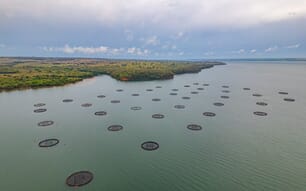If current trends are to follow, the next big fish in the pond are Redclaw Crayfish, and Basa Catfish. Philip Cruz of Cruz Aquaculture Corporation said that there is a rapid growth and favorable business opportunities with these three species during the recent Mindanao Food Congress held in Davao City.
“These three aquaculture species are available for culture with favorable farming traits such as efficient feed converters, labor and space saving, and can be cultured in variety of environment,” he told AgriBusinessWeek.
Vannamei or White Shrimp
According to AgriBusinessWeek, the development of White Shrimp (Penaeus vannamei), which is now the dominant shrimp species in Asia, presents a promise for the country’s aquaculture industry.
Cruz said White Shrimp is a high-value product that is cheaper to produce not only because of its lower fry cost but because it also has better growth and culture qualities. This shrimp variety is ideal for small fish operators as higher yield is achieved in shorter culture period with less aeration, water exchange, and low protein requirement. The feed conversion ratio (FCR) for White Shrimp is 1.5. This mean that it is more efficient than the Tiger prawns whose FCR is 2.
“White Shrimp suits well in the closed or semi-closed system of culture which dramatically improves biosecurity. It is adaptable to lower water quality and reduced water exchange rates and can sustain a cleaner and more stable environment due to lower waste production and lower nutrient loading,” Cruz told the news organisation.
A pond, size of 5,000-50,500 m2 and a pond depth of 1.0-1.4 m can have a stocking density of 5-250/M2 with stocking size of PL 8-120. This type of culture system will have a short period, from three to four-and-a-half months only. With a survival rate of 60-80 percent, it can attain a yield per hectare of 300-12,000 kg per crop.
“We’re quite late in Vannamei production as this had been knocking on our doors as early 2004. But we can still be optimistic and catch up with its growing demand. We can even-tap existing bangus fishponds for polyculture,” Cruz said.
Once the potentials of this variety are effectively explored, Cruz said that this will help the Philippines to be a major shrimp exporter again in just two years.
Redclaw Crayfish
The Red Crayfish (Cherax quadricarinatus) is a freshwater crustacean that looks very similar to lobster.
“It’s actually not a fish but a shrimp. Originating from the Old High German word krebiz which means edible crustacean, the variation in Anglo Norman pronunciation led to the English word crayfish,” Cruz said.
At maturity, crayfish can be as small as 2 centimeter (the Dwarf Crayfish) to as big as 6 kilograms (the giant Tasmanian Crayfish). It is valued in the culinary world both -for its visual appeal and excellent taste. When cooked, it looks like a lobster as its color turns bright red while the taste is in between freshwater prawns and marine shrimp but its meat is more tender and succulent.
Based on Cruz’s observation, crayfish is hardly suited to upland or lowland environments. Culture systems for a pond size of 1,000-2,500 in and pond depth of 1.2-2.5 m will require a stocking density of 5-15, /in and stocking weight of 510 g (advanced juvenile) with a survival rate up to 80 percent. The culture period is from six to nine months with FCR of 1.5-2.5 and a harvest weight of 50-100 g. Yield per hectare can reach from 800 up to 2,500 kg per crop.
Cruz also said that crayfish is best marketed live as wholesalers tend to price it higher than shrimps and prawns. He added that it is also easier to transport crayfish live as it no longer needs oxygen or ice. Marketable crayfish is purged 24 hours before selling and is often held in saltwater to enhance its flavor and appearance.
Basa Catfish (Pangasius)
Although it is introduced in the country as aquarium fish, Basa Catfish or Pangasius hypopthalmus is a freshwater fish that has been served as fish fillet in most restaurants in the country. Also known as Suchi or Striped Catfish, Pangasius was first artificially bred in Vietnam in 1995. Vietnam had been earning with their Pangasius exports, to 40 countries. In 2005, it has exported 89,300 metric tons of Pangasius fillet, generating US$212.3 million revenue.
Even if it is comparable to the Tra Catfish (Pangasius bocourti) the Basa Catfish is more popularly cultured as it is easier to bredd, cheaper to farm, and provides greater fillet yield. It is highly tolerant to poor quality water environment and can be feed on almost all types of feeds, from commercial pellet to home-made feeds.
Culture of Basa Catfish in a pond size of 1,000-5,000 in’ and pond depth of 3.54.5 m would require a stocking density of 25-35/m2 and stocking size of 1.5-2.5cm. Survival rate is as high as’80-90 percent. With FCR of 1.5 to 2, the culture period will last from six to seven months with harvest size of 1,000-1,200 g. Projected yield per hectare can reach from 200,000 to 300,000 kg per crop.
Cruz said the need to tap inland aquaculture has become more pressing considering that majori,py of our fishing ground had been overfished which resulted in decreased fish production while our population continuously increases.
“In the last 20 years, due to overfishing, habitat destruction, and pollution, catches from traditional fishing grounds have dropped by as much as 90 percent. The crisis in the fishing industry is now a very real threat to food security, jobs, and livelihood,” he added.
He also said that scientific data indicate that current growth rate is not anymore sustainable. For wild stocks to recover, fishing activities should be drastically reduced.
On one hand, his advice for those who will be affected by the decline in fishery production: “Go for aquaculture, [because] if you can’t hunt it, then farm it.”



